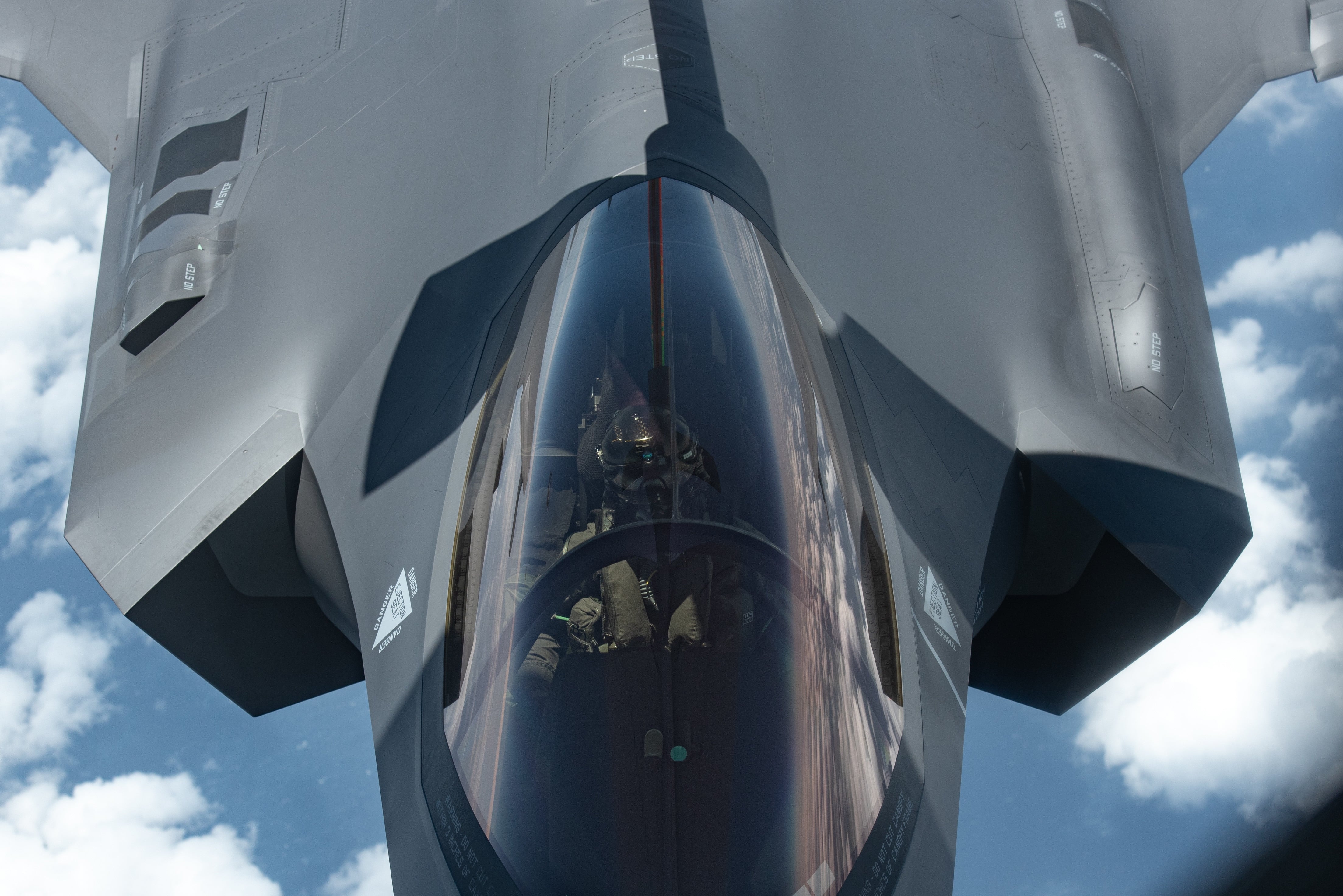Five years after the U.S. military began to see a spike in reports of dangerous mental and physical effects experienced by troops in flight — particularly those in fighter and training jets — aviators are breathing easier.
Concerted efforts to curb incidents of hypoxia and other physiological episodes across the Air Force, Navy and Marine Corps cut the number of reported events from 376 in 2018 to 142 in 2022, or 62% in five years, Military Times has found.
RELATED
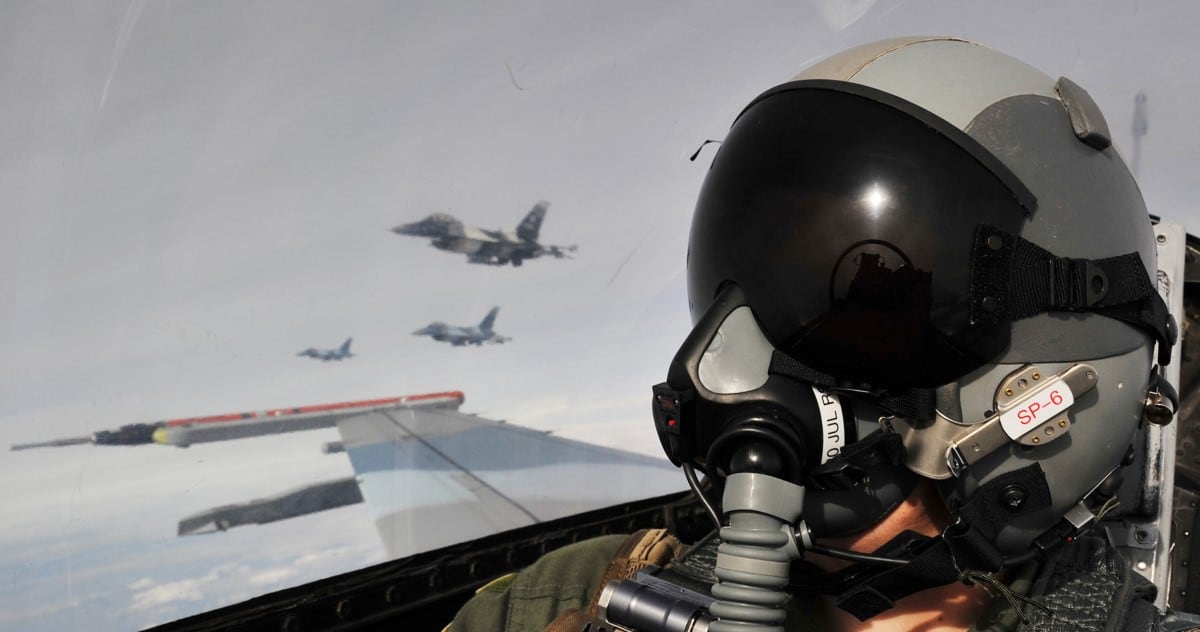
Military Times requested data on all physiological episodes recorded by the Air Force, Navy and Marine Corps between fiscal 2017, when the military began sounding alarms about its latest PE crisis and fiscal 2022, the most recently completed fiscal year.

This is the most complete public accounting of physiological episodes in the three branches of the armed forces that own the vast majority of the Pentagon’s fixed-wing inventory, which is disproportionately affected by those incidents. The data also includes their rotary-wing and tiltrotor fleets, and covers the active duty, Guard and Reserve components.
The numbers show that the services — particularly the Navy and Marine Corps — have made significant strides to eradicate physiological episodes. But they also reveal major accidents that went previously unreported, and highlight airframes that continue to have problems without many answers.
“We’re trying to create that proactive safety mindset, on- and off-duty. … We continue to watch the trends,” Air Force safety chief Maj. Gen. Jeannie Leavitt, who also chairs the Pentagon’s Joint Safety Council, told Military Times.
A wide range of aircraft
Airmen, Marines and naval aviators reported 1,543 in-flight physiological episodes between 2017 and 2022, according to data provided to Military Times.
The Air Force’s T-6A training turboprop plane logged the most PEs in that span of time at 285 incidents, or nearly one-fifth of all episodes.
The Navy’s F/A-18E Super Hornet recorded the next-highest number at 134, followed by the Air Force’s F-16C Fighting Falcon (114) and the F/A-18C fighters (91) and the EA-18G Growler electronic attack planes (91) used by the Navy and Marine Corps.
Others, like the Air Force’s E-3 Sentry airborne target tracking planes, see an outsized number of physiological episodes compared to the number of jets in the fleet. The Sentries have logged 16 incidents in the past five years, despite having just 31 aircraft.
Most often, PEs involve signs of hypoxia, or a lack of oxygen in the bloodstream. Other instances range from spatial disorientation to unconsciousness caused by pulling Gs in flight, physical reactions to smoke in the cockpit, changes in air pressure and more.
At best, those symptoms are more uncomfortable than debilitating. At worst, they can render pilots confused or unconscious and can lead to deadly crashes.
In the six years Military Times studied, most physiological episodes — two-thirds of those listed in the past six years — were reported as hazards or as self-reported notes to flag potential issues. Those fell from a recent high of 253 in 2018 to 105 in 2021. They may be on the rise again, ticking up to 114 in 2022.
Leavitt attributes the recent increase in hazard reports to efforts to encourage troops to flag symptoms early and often. Those reports aren’t turning up new or unexpected ailments, she noted.
“If we have more reporting, that’s a good thing, because then we can get more information, more data and do a better job at root cause analysis,” she told Military Times.
About one-third of the physiological episodes were severe enough to be counted as official mishaps — though that count plummeted from 155 in 2017 to 28 in 2022. Mishaps can range from minor illnesses and injuries, to incidents causing millions of dollars in damages and dead pilots.
Most official mishaps were recorded as Class C and D incidents, costing between $25,000 and $600,000 or causing a nonfatal injury that could keep someone home from work. Those have declined from around 130 in 2017 to 17 in 2022.
Many of those events go unreported because they aren’t as extreme or public as a crash, or because no one died.
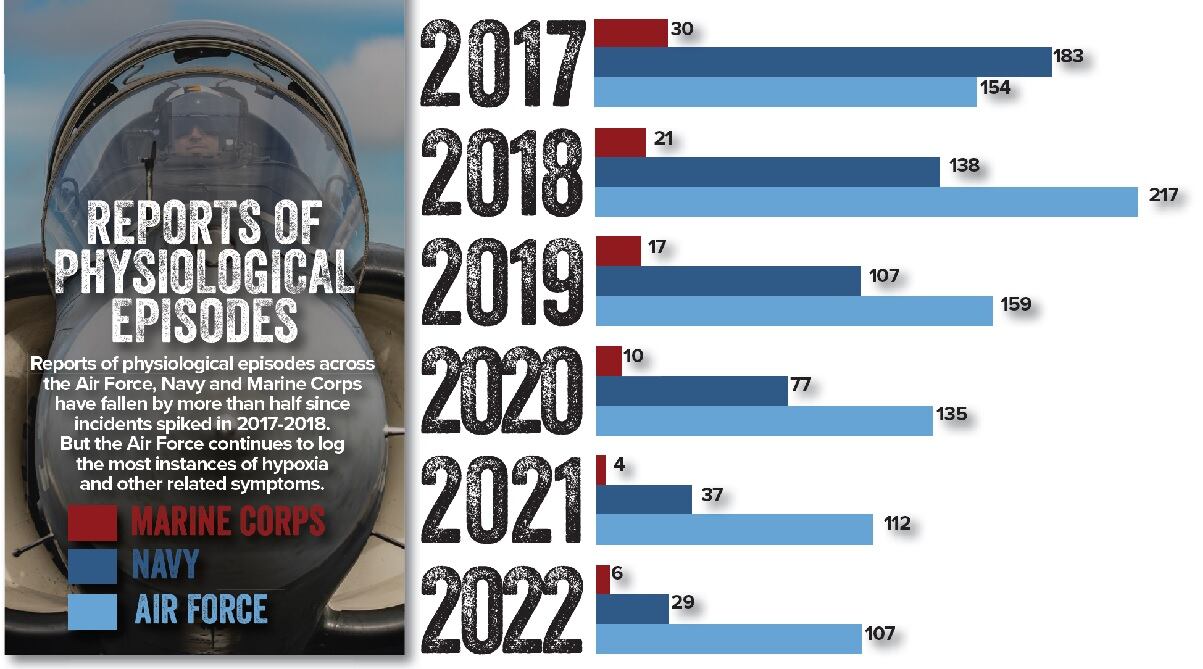
The most destructive and deadly instances, known as Class A and B mishaps, often come to light through official statements and news reports. Class A incidents result in a fatality or permanent disability or at least $2.5 million in damages; Class Bs cause permanent partial disability, the hospitalization of three or more personnel, or between $600,000 and $2.5 million in damages
Data provided to Military Times, however, showed physiological effects caused three Class A incidents that were never made public.
On March 21, 2019, G forces rendered a student pilot in the Oregon Air National Guard unconscious while performing basic maneuvers in an F-15C Eagle fighter jet. The pilot was able to land the aircraft and safely returned to Kingsley Field in southern Oregon, according to the 173rd Fighter Wing and the Air Force Safety Center.
The jet suffered at least $2.5 million in damages, but Air Education and Training Command opted not to launch an accident investigation board because it wasn’t destroyed, Safety Center spokesperson Keith Wright said.
A Marine Corps UH-1Y Super Huey utility helicopter suffered an undisclosed Class A mishap on Aug. 2, 2018. Maj. Mason Englehart, a spokesperson for the 3rd Marine Aircraft Wing, declined to provide details of the event because they are designated as “controlled unclassified information.”
Military Times also found that the Navy never publicly disclosed a Class A incident in an F/A-18F Super Hornet jet on Aug. 5, 2017. The service did not respond to a request for more information on the accident by press time.

Still, the services have managed to eliminate their worst PE-related accidents over the past six years. No Class A or B events were reported as a result of physiological episodes in 2022, military data shows.
They have steadily decreased from fiscal 2017, when five Class A mishaps were recorded across five airframes: a Navy EA-18G Growler electronic attack plane, an F-5N fighter used in air-to-air combat simulations, and an F/A-18F Super Hornet fighter jet; and a Marine Corps F/A-18C Hornet fighter and MV-22B Osprey tiltrotor aircraft.
That year marked a crisis point in the most recent spike of physiological episodes, affecting several aircraft fleets across the Air Force, Navy and Marine Corps.
The Navy acknowledged in June 2017 that four F/A-18 pilots had died from a lack of oxygen in the cockpit over the previous decade, after its instructors refused to fly in protest of similar issues with the T-45 Goshawk jets.
Air Force pilots also began flagging unusual symptoms more often, on a range of aircraft at different altitudes and speeds — particularly on the T-6 fleet used to teach basic flying skills, the A-10C “Warthog” ground attack plane and the F-35 Lightning II.
The Air Force and Navy temporarily grounded multiple aircraft fleets to investigate the problem, while Congress hauled service officials to Capitol Hill to testify on the matter. Both departments created “action teams” to spearhead their efforts to bring the numbers down.
In the Air Force, more than 400 physiological events between 2017 and 2022 involved “hypoxia-like” symptoms across seven airframes: the F-15, F-16, F-22 and F-35 fighter jets, the A-10 attack plane and the T-6 and T-38 trainer aircraft, according to data collected by the Air Force Physiological Episodes Action Team.
Those have fallen from a high of 135 in fiscal 2018 to 40 in 2022, the service said.
Five years after that spike, Air Force planes topped the list of airframes with the most reports of physiological episodes in fiscal 2022: the T-6A (42), F-16C (11), A-10C (9), T-38C (9) and F-35A (6). Hypoxia-related symptoms remain the most frequent issue, the service said.
Air Force incidents accounted for three-quarters of the three services’ physiological episodes last year. (Military Times could not calculate how frequently the problems arose because the services declined to provide the number of hours each airframe flew per year.)
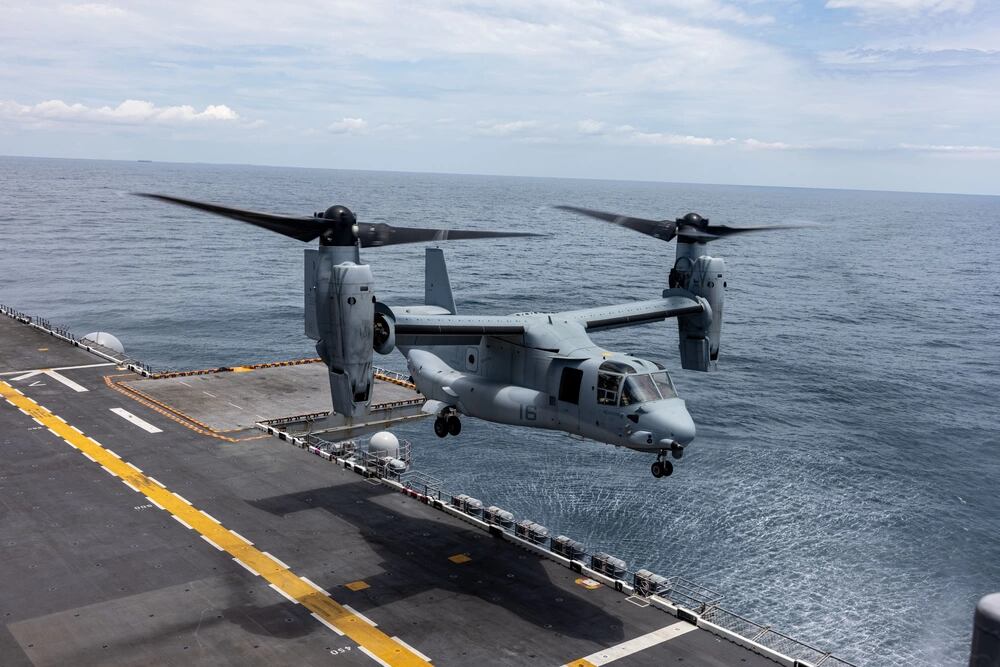
For instance, the Pentagon’s F-35 Joint Strike Fighter fleet logged 44 physiological episodes over the six-year period analyzed by Military Times. Thirty-two of those occurred on Air Force jets, including six of the seven incidents reported in 2022.
Similarly, the Navy and Marine Corps version of the T-6 has reported fewer than 10 episodes each year since 2019. The Air Force’s T-6 fleet has averaged 40 per year in that same time.
One Air Force T-6 instructor pilot told Military Times the generation of experienced pilots who flew the plane during the spike have kept the issue at the forefront of emergency procedures.
“I don’t think anyone has reservations about the T-6,” he said. “If there’s an improvement to be made, it’s just being self-aware. Training does that.”
Non-fighter aircraft are often excluded from the public conversation about physiological episodes, but can rise near the top in annual data.
The Air Force’s KC-135R tanker had five reported incidents last year — the same as the Navy’s T-45C trainer, the EA-18G and F/A-18E jets — followed by the E-3 AWACS at four.
Other airframes outside the fighter, attack and trainer fleets that have led the Pentagon in physiological episodes in the past six years include the KC-135, variants of the Air Force’s C-130 cargo aircraft, as well as the Navy’s MH-60S Seahawk helicopter (33, 32 and 27 incidents, respectively).
Aviators on those platforms can suffer from reactions to smoke and fumes in the cabin, or from gas that is trapped in their sinuses while changing altitude. Those types of events become part of discussions around future system upgrades if caused by electronics fires, or in the medical community, the Air Force said.
“With some of the platforms … we have a lot of airplanes, and they fly pretty long sortie durations, so there’s more exposure time,” Leavitt said of larger airframes. “In some cases, there is the problem with aging fleets, but we need to have systems that proactively prevent those problems.”
The Air Force said it may account for an outsized share of the data because it owns more airframes than the Navy or Marine Corps.
“The Air Force has also fostered a culture of reporting even the smallest of symptoms to help us better understand PEs and their potential causes, which may appear to slow progress,” the service said. “Additionally, we are still working to develop sensors to monitor both the human and the aircraft breathing systems … to target specific areas for future improvements.”

The Department of the Navy attributes its success to a combination of improvements in how it records data on aircraft, more proactive maintenance, better education on the subject and new in-flight emergency procedures.
Physiological episode data provided by the military has fluctuated over time, though it’s unclear why.
In some instances, Military Times obtained different numbers of episodes per aircraft than those reported in previous studies by the National Commission on Military Aviation Safety and the Pentagon’s inspector general.
For example, the NCMAS report shows F-16 incidents rose from approximately 40 to 50 episodes between 2017 and 2018, while data given to Military Times includes 33 F-16 incidents in 2017 and 34 in 2018.
And when cases spiked in the T-6A in 2018, Military Times data showed that number rose to 94 episodes — fewer than the NCMAS chart, which showed at least 100 episodes, but more than a 2021 Pentagon inspector general report that listed 86 incidents.
PE numbers could change over time as a result of investigations into their causes, or because of differences in how the military reported its numbers to those who sought the information. The Air Force Safety Center did not answer a May 24 query on why those figures may differ.
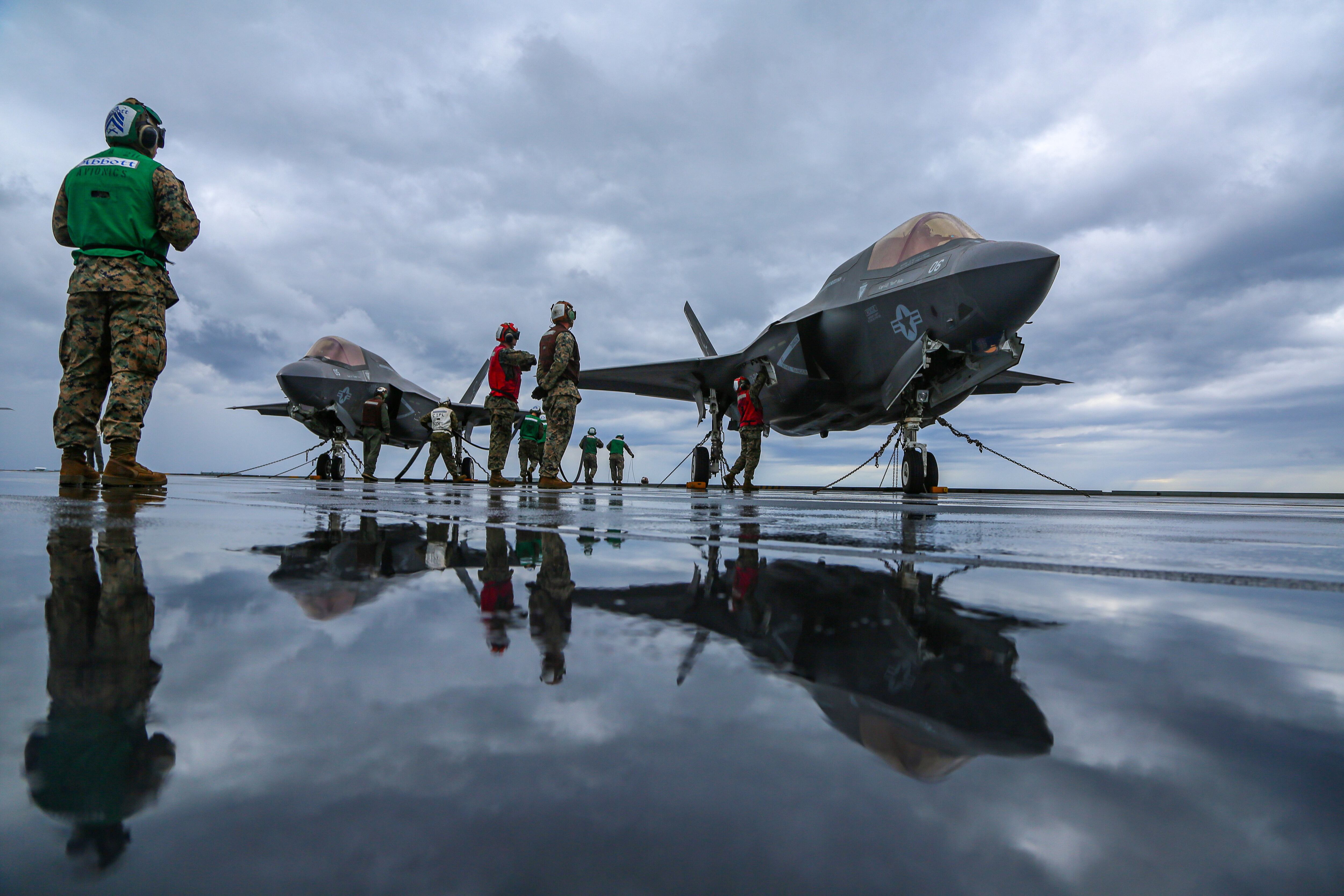
Searching for answers
The services found explanations for the root causes of about 94% of reported PEs, the National Commission on Military Aviation Safety said in its sweeping 2020 report. But those answers haven’t always come easily, and plenty of questions remain.
No single cause is responsible for physiological episodes, the commission said.
“They are unpredictable and inconsistent, even when the same aviator is flying the same aircraft and executing the same maneuvers,” the commission wrote. “They also are not easily replicable by researchers trying to better understand what is happening to the individual inside the aircraft.”
Unexplained incidents could point to still-unknown problems with the aircraft themselves, or correlations between certain flight conditions and the human body’s reaction.
For example, 7 in 10 incidents logged by the Navy and Marine Corps over the past six years were classified as “physiologic events,” or those not caused by a known system failure.
As the Department of the Navy learned more about the problems at hand, the number of cases that couldn’t be attributed to a particular system failure fell from 166 across the two services in 2017 to 21 in 2022.
The Navy now believes hypoxia is not to blame for most breathing difficulties in flight.
“Hypoxia is certainly possible in very specific circumstances, but our increased understanding of both the aircraft systems and human physiological responses has led to the conclusion that hypoxia is not the main driver of” those incidents, the service said.
The Air Force continues to view most incidents through the lens of hypoxia. But those investigations don’t always lead to answers.

On Nov. 12, 2020, one experienced crew member on an Air Force RC-135W Rivet Joint out of Offutt AFB, Nebraska, was flying a training sortie when they noticed air was leaking out of the jet’s escape hatch.
“This isn’t abnormal, and I’ve seen/heard it before with no issues,” the airman said in an incident report that Military Times obtained via the Freedom of Information Act.
But within a few minutes, the airman was struggling to breathe and their vision had blurred, the report said. Their symptoms lifted once they turned to supplemental oxygen, and because no one else felt ill and the electronic signals reconnaissance jet was otherwise steady, the training flight continued.
The report said the debrief afterward didn’t mention any pressurization problems. Four days later, five airmen also felt hypoxic during a sortie on the same Rivet Joint.
“After investigation, there were no discrepancies in the pressurization system that would lead to hypoxia,” the report said. “[It] remains unknown if the member who submitted the [report] experienced hypoxia or some other physiological reaction that felt like hypoxia, and why that happened.”
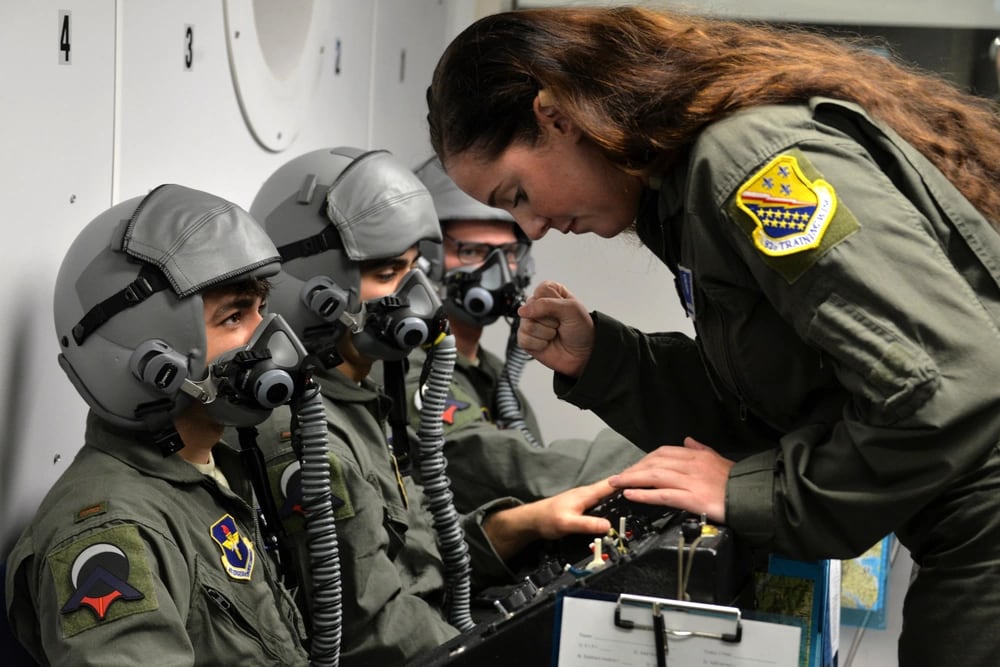
Deep dives
Hundreds of items are part of the services’ checklists for driving down the number of cases, from tweaking maintenance procedures to ensuring an aviator’s gear fits correctly. To better understand the problem, the military is trying to crunch as much data as it can.
The services are pursuing new sensors and redesigned oxygen systems that can track the vital signs of fighter pilots and oxygen levels in the cockpit. And they’re trying to compile all of the information, including what aviators self-report, into a more accessible database that can uncover possible new trends and causes.
The Air Force says new aviators familiarize themselves with hypoxia symptoms through 50 hours of lessons on physiological episodes during initial flight training, plus a refresher course every five years.
Airmen learn to recognize those effects by sitting in a pressurized metal chamber that gradually sucks out the oxygen, and by trying to fly a simulator while wearing an oxygen-deprivation mask.
The services are also implementing a slew of material fixes. For instance:
- On the T-6A, all planes are slated to receive a new version of the Onboard Oxygen Generation System, one of multiple breathing devices used in military aviation, by the end of the year, the Air Force said. Now OBOGS should deliver a more consistent flow of oxygen-rich air to breathe, which it pulls from an aircraft’s engine compressor and purifies. If that’s not enough, pilots have supplemental oxygen onboard.
- On the F-16 and A-10, the Air Force is looking at redesigning onboard breathing systems to deliver oxygen-rich gas faster. In the meantime, airmen have to run the system before takeoff so they aren’t flying before it begins pumping out the best air.
- On the F-35A, the service is prioritizing training and response procedures while it runs more tests on how people respond to the newest breathing system in the inventory.
- On the F/A-18, the Navy has started upgrading its avionics, asked pilots to record air pressure data in the cockpit and keeps track of components that could soon fail. It’s also studied factors from dehydration to sleep that can spur odd symptoms.
The Air Force is developing a new oxygen mask with improved inhalation and exhalation valves for high fliers, and inspecting components that are supposed to make breathing easier but may fall short of new military standards.
Another boon to pilot safety is a Lockheed Martin-built tool known as the Automatic Ground Collision Avoidance System, or “Auto GCAS.” The software can detect when a distracted or unconscious pilot is in danger of crashing, and pulls the jet out of harm’s way until the pilot is able to fly.
Auto GCAS has saved the lives of 16 pilots in 12 F-16s and three F-22s since the Air Force began installing it onto jets in 2014, the Air Force Safety Center said May 25. The F-35A Lightning II fleet also received Auto GCAS in 2019.
The Air Force’s future F-15EX Eagle II fighter and T-7 Red Hawk training jet are expected to be delivered with a non-automatic version of anti-crash technology, the Safety Center said. The service could add in the autopilot later.
The Department of the Navy is looking into adding Auto GCAS to the F/A-18 fleet as well.

Next steps
Leavitt said the Joint Safety Council will be updated on the services’ efforts on physiological episodes at the group’s next meeting in June.
The council is a great venue for sharing ideas and best practices, Leavitt said, but it’s no silver bullet: “At the end of the day, the actual platforms have different oxygen systems.”
Analysts have warned that the military needs to think one step ahead of potential issues as aerospace technology continues to advance.
“For the next generation of aviators, aircraft will reach new levels of performance and pose increasing physiological challenges,” the NCMAS report said. “Keeping the aviator safe while performing at the highest levels requires a fuller knowledge of the human in high-performance flight in order to build both human and machine survival into the aircraft’s design.”
Leavitt said the Air Force wants to apply what it’s learned about breathing systems to future aircraft designs, particularly as it works with Boeing to build the T-7 trainer. If the team can test metrics like oxygen concentration levels up front, it may be able to create a jet that avoids physiological episodes altogether.
“We’re very much trying to incorporate lessons learned from other platforms — what works, what doesn’t, and identify potential issues before they become actual issues,” she said.
